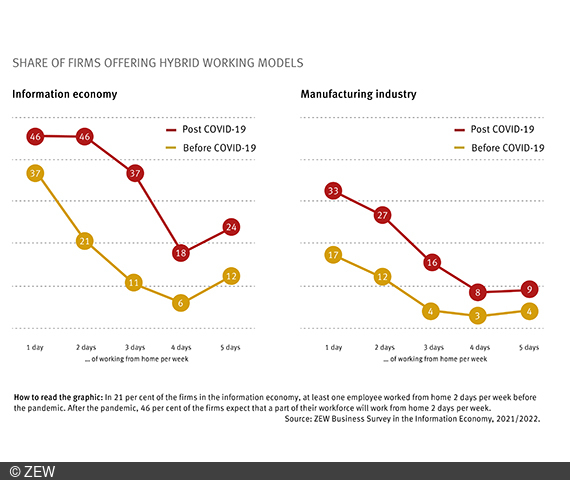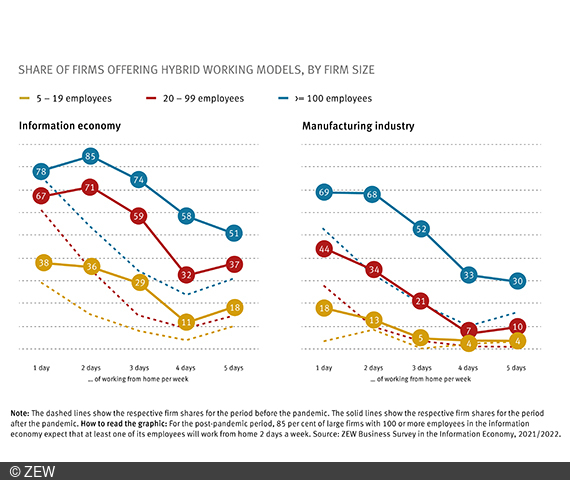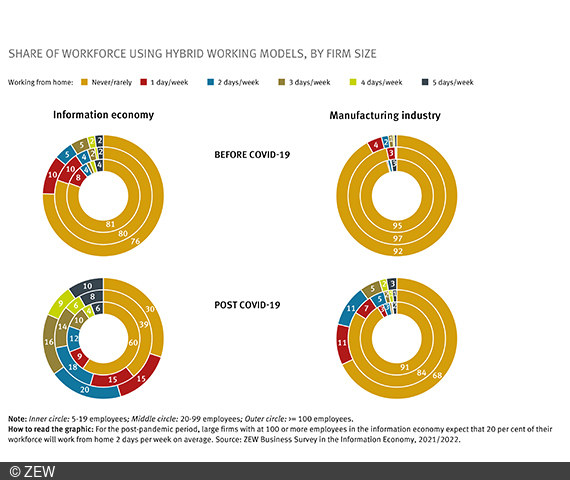Firms Plan to Maintain Hybrid Working Models After the Pandemic
Information EconomyBusiness Survey in the Information Economy and Manufacturing Industry
Many firms in Germany are planning to offer hybrid working arrangements after the end of the COVID-19 pandemic, thus enabling employees to have a part-home, part-office schedule. A business survey conducted by ZEW Mannheim in December 2021 and January 2022 now provides further insights into firms’ expectations about the allocation of working hours in the long run. In both the information economy and the manufacturing industry, firms are mainly planning to offer hybrid models in which employees work from home 1-3 days per week. The share of employees who will work from home several times a week post COVID-19 is significantly higher than before the pandemic, according to the firms’ estimates.
Around 1,200 firms from the manufacturing industry and the information economy, which includes the ICT sector, media service providers and knowledge-intensive service providers, took part in the representative survey. The firms were asked how often they had used hybrid working models before the pandemic and to what extent they plan to offer them after the pandemic. The hybrid working models differed in the number of home-working days, ranging from 1 to 4 days per week. In addition, the model with 5 home-working days per week has been surveyed and is sometimes subsumed under the term hybrid model in the following text for better readability. For each of the five models, the firms indicated the share of employees likely to use that model.
Before the pandemic, 37 per cent of firms in the information economy offered at least one of their employees the option of working from home 1 day per week. Hybrid models with 2 or 3 home-working days per week were still much less common, with a firm share of 21 and 11 per cent respectively. “In the past two years, the share of firms that want to implement hybrid working models in the long term has risen sharply. In the information economy, for example, almost every second firm is planning to use hybrid working models post COVID-19, where employees can work from home for 1-2 days. Hybrid set-ups that allow some employees to work from home 3 days a week are planned by 37 per cent of firms. That is more than three times as many as before the pandemic,” says Dr Daniel Erdsiek, researcher in the ZEW “Digital Economy” Department. The share of firms that want to allow employees 4 days of home-based work has also tripled and currently stands at 18 per cent. In addition, almost every fourth firm in the information economy assumes that some of its employees will generally work from home 5 days a week.
“Compared to the information economy, far fewer tasks in the manufacturing industry are suited for remote work. Nevertheless, COVID-19 has led to a sharp increase in the number of working from home arrangements in this sector as well,” says Erdsiek. For the post-pandemic period, every third firm plans to allow some of its employees to work from home 1 day per week. In addition, some firms are also considering hybrid models with 2 days (27 per cent), 3 days (16 per cent) or 4-5 days (8 per cent) of remote working. Before the pandemic, the corresponding shares were only 3-17 per cent of firms.
Larger firms in particular want to make frequent use of remote working models
Hybrid working models are experiencing a long-term and sustained upswing among both small and medium-sized enterprises as well as large firms. “Each of the hybrid models covered in the survey will be more widespread after the pandemic than before, according to the firms’ estimates. Larger firms will be particularly likely to establish working from home arrangements,” says Erdsiek. In the information economy, more than three-quarters of the firms with at least 100 employees plan to use hybrid models with 1-3 home-working days. In about half of the large firms, some employees are likely to work from home on 4-5 days. In manufacturing, large firms also frequently plan to use hybrid models with 1-2 days (68 per cent), 3 days (52 per cent) or 4-5 days (30 per cent) of working from home per week.
Share of employees using hybrid working arrangements expected to rise
As the results show so far, many firms expect to use hybrid working models in the long term. However, the results do not yet provide any information on how many employees will actually have a part-home, part-office schedule. Therefore, an important question is how large the share of employees will be who are likely to work in each of the hybrid set-ups.
How extensively the hybrid models are used in the firms depends heavily on their size. Large firms in the information economy assume that only 30 per cent of their employees will work full-time in the office on average. In small firms, on the other hand, this share is twice as high. On average, large firms indicate that their employees will be distributed among the hybrid models as follows: 15 per cent of the workforce will probably work from home 1 day per week, 20 per cent on 2 days, 16 per cent on 3 days and about 9 per cent each on 4 or 5 days. All in all, half of the employees of large firms in the information economy are expected to work from home on 1-3 days per week on average. In small firms with 5 to 19 employees, this applies to about 30 per cent of the workforce.
In the manufacturing industry, the share of employees whose tasks can be done at home is significantly lower than in the information economy. Nevertheless, firms in this sector also plan to make greater use of remote working arrangements in the future. This is especially true for large firms, where on average about a quarter of the workforce is expected to work from home on 1-3 days after the pandemic. In small firms, it is estimated that only 7 per cent of the workforce will do so.
A before-and-after comparison clearly shows the impact of COVID-19 on long-term working from home arrangements in firms. Before the pandemic, an average of 8 per cent of staff in large manufacturing firms had a part-home, part-office schedule. After the pandemic, this share will grow to an average of 32 per cent. In large firms in the information economy, an average of 70 per cent of the workforce is expected to work in hybrid models, compared to only 24 per cent previously.



